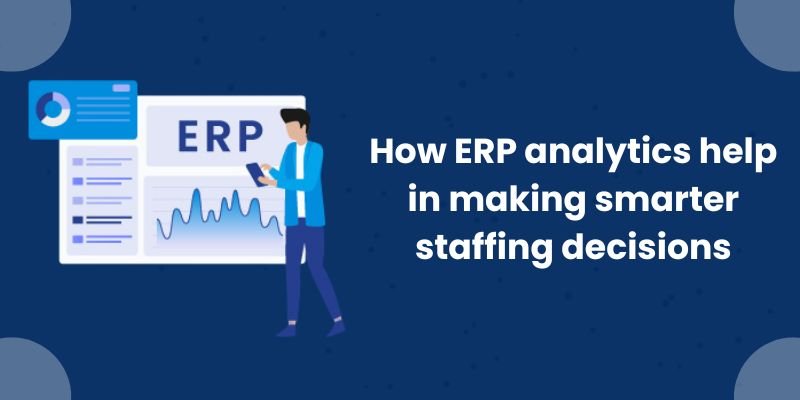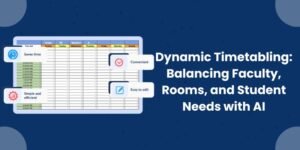In the dynamic world of educational management, staffing is more than just filling vacancies. It’s about deploying the right resources in the right places at the right time. But how can school leaders ensure they’re making the most informed decisions when it comes to recruitment, allocation, retention, and performance evaluation?
The answer lies in ERP analytics.
Modern education ERP systems do more than automate daily operations. They collect, process, and display critical data points that support data-driven decision-making. This is especially valuable when it comes to staffing—an area that directly impacts the quality of education, operational efficiency, and student outcomes.
Let’s explore how ERP analytics are reshaping staffing strategies in educational institutions.
Understanding ERP Analytics in Education
An Enterprise Resource Planning (ERP) platform is a centralized system that connects various departments—academic, HR, finance, admissions, and more—under one digital ecosystem. Over time, the system accumulates data that reveals patterns, trends, and gaps.
ERP analytics refers to the insights drawn from this data, typically visualised through dashboards, reports, and alerts. These analytics give educational leaders a bird’s-eye view of staffing operations—allowing them to respond proactively rather than reactively.
From understanding absentee trends to predicting workforce needs, ERP analytics equips institutions with the information they need to staff smarter.
Key Ways ERP Analytics Supports Smarter Staffing
1. Workforce Planning Based on Historical Trends
ERP systems store years’ worth of staffing data, including:
- Faculty schedules
- Leave patterns
- Attrition rates
- Peak demand periods (e.g., exam months, admission season)
With this historical data, institutions can predict staffing needs before they arise. For example, if ERP analytics show that student enrolment increases by 15% every July, HR can plan to onboard part-time educators or redistribute faculty loads in advance.
This proactive staffing approach ensures continuity and prevents last-minute scrambling.
2. Identifying Workload Imbalances
ERP dashboards can highlight workload disparities among staff. Through metrics like:
- Number of teaching hours per faculty
- Student-to-teacher ratios by department
- Number of administrative tasks handled
Administrators can spot and address inefficiencies or overburdened teams.
For instance, if the English department shows higher teaching hours than other departments, it may prompt a review of course assignments or justify hiring another lecturer. This not only improves staff morale but also helps prevent burnout and turnover.
3. Tracking Leave and Attendance Patterns
One of the most immediate benefits of ERP analytics is real-time attendance tracking. HR managers can identify:
- Frequent absenteeism
- Extended leave trends
- Departments operating with minimal backup
Patterns like repeated absenteeism or clustered leaves may point to systemic issues—stressful workloads, low engagement, or insufficient team capacity. Addressing these patterns helps institutions maintain operational stability and staff satisfaction.
Moreover, ERP analytics can help automate substitute teacher management—alerting HR when a staff member’s absence may impact classroom continuity.
4. Recruitment Decisions Backed by Data
Rather than relying on gut feeling or manual spreadsheets, ERP analytics supports data-backed recruitment. When planning new hires, institutions can refer to:
- Class sizes and growth trends
- Subject-wise student preferences
- Faculty-student performance metrics
- Teacher feedback and evaluations
This allows leaders to make targeted recruitment decisions—whether that’s hiring a specialised physics tutor for Class XII or expanding the counselling team due to increased student stress reports.
5. Improving Retention Through Performance Insights
ERP analytics offer a complete view of staff performance, combining both qualitative and quantitative metrics such as:
- Student feedback scores
- Submission of assignments and lesson plans
- Participation in co-curriculars or training
- Timeliness in administrative tasks
This comprehensive insight helps in designing fair appraisal systems, offering professional development opportunities, and creating incentive structures that encourage retention.
Moreover, ERP data can be used to spot early warning signs. For example, a steady decline in engagement metrics for a staff member could prompt timely support or intervention.
6. Supporting Diversity and Inclusion Goals
Many institutions today aim for a diverse and inclusive workplace. ERP analytics can track and support this vision by showing:
- Gender distribution across departments
- Inclusion of differently-abled staff
- Representation in leadership roles
With this data, institutions can take measurable steps toward equitable staffing practices and publish transparent diversity metrics in reports or accreditation applications.
Imagine This
Let’s say a school notices student complaints about delayed assignments and low interaction in Class X science. Rather than assuming the teacher is underperforming, the ERP dashboard reveals:
- The teacher handles 32 periods per week across multiple classes
- Has taken no leave in six months
- Also manages administrative exam duties
This comprehensive view leads the leadership to redistribute workload, assign support staff, and offer mentorship—not replace the teacher. The result? Improved morale, better classroom performance, and a fairer evaluation process.
How to Maximise ERP Analytics for Staffing
To get the most out of ERP analytics:
- Ensure consistent data entry: Accurate data leads to accurate insights. Staff should be trained to use ERP consistently and correctly.
- Customize dashboards: Tailor visualizations for different users – HR, academic heads, finance – so each sees the data most relevant to their decisions.
- Schedule regular reports: Monthly or quarterly analytics reviews help track progress, course correct, and build institutional memory.
- Encourage cross-departmental collaboration: Use analytics to open conversations between departments and break silos.
Staffing is both an art and a science. While intuition, empathy, and leadership remain essential, the power of data analytics transforms staffing into a more precise, strategic, and equitable function.
By leveraging ERP analytics, institutions can:
- Optimise human resources
- Support staff well-being
- Improve student outcomes
- Ensure financial sustainability
It’s no longer enough to rely on assumptions. Data-driven staffing is the future of institutional excellence – and ERP is the bridge that gets us there.












